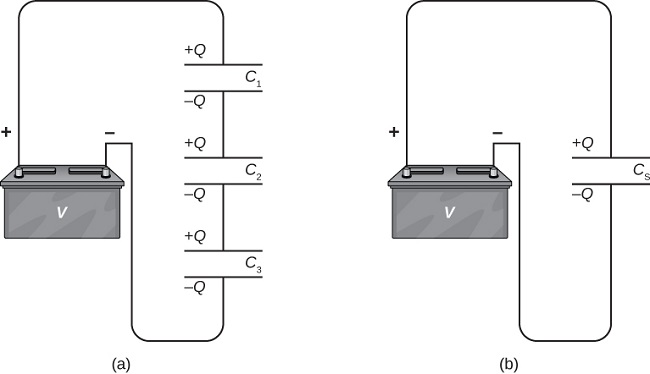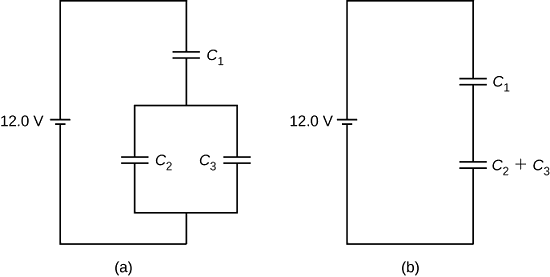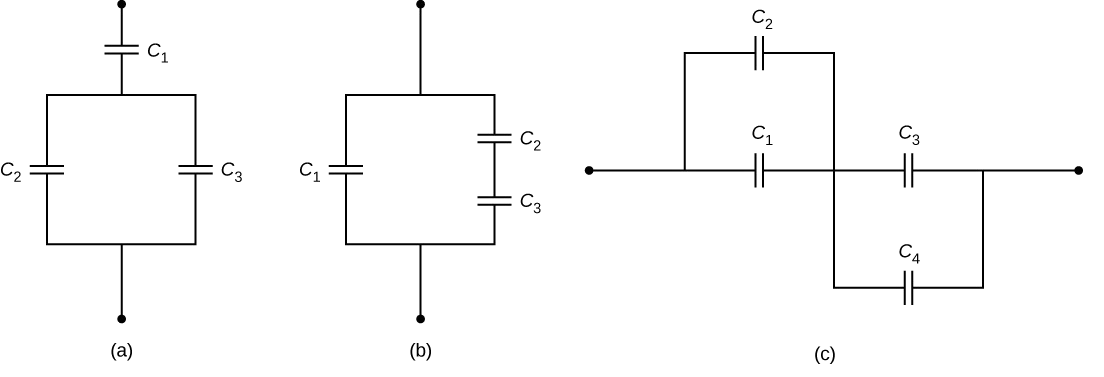8.3: Wafanyabiashara katika Mfululizo na Sambamba
- Page ID
- 176327
Mwishoni mwa sehemu hii, utaweza:
- Eleza jinsi ya kuamua capacitance sawa ya capacitors katika mfululizo na katika mchanganyiko sambamba
- Kuhesabu tofauti tofauti katika sahani na malipo kwenye sahani kwa capacitor kwenye mtandao na kuamua uwezo wavu wa mtandao wa capacitors
Wafanyabiashara kadhaa wanaweza kushikamana pamoja ili kutumika katika programu mbalimbali. Uunganisho mingi wa capacitors hufanya kama capacitor moja sawa. Capitance ya jumla ya capacitor hii sawa inategemea wote juu ya capacitors binafsi na jinsi wanavyounganishwa. Wafanyabiashara wanaweza kupangwa katika aina mbili rahisi na za kawaida za uhusiano, inayojulikana kama mfululizo na sambamba, ambayo tunaweza kuhesabu kwa urahisi uwezo wa jumla. Mchanganyiko huu wa msingi, mfululizo na sambamba, pia unaweza kutumika kama sehemu ya uhusiano mgumu zaidi.
Mchanganyiko wa Mfululizo wa Capacitors
Kielelezo\(\PageIndex{1}\) inaonyesha mchanganyiko mfululizo wa capacitors tatu, mpangilio mfululizo ndani ya mzunguko. Kama kwa capacitor yoyote, capacitance ya mchanganyiko ni kuhusiana na malipo na voltage:
\[ C=\dfrac{Q}{V}.\]
Wakati mchanganyiko huu wa mfululizo umeunganishwa na betri yenye voltage V, kila mmoja wa capacitors hupata malipo sawa Q. Ili kueleza, kwanza kumbuka kuwa malipo kwenye sahani kushikamana na terminal chanya ya betri ni\(+Q\) na malipo kwenye sahani kushikamana na terminal hasi ni\(-Q\). Mashtaka ni kisha ikiwa kwenye sahani nyingine ili jumla ya mashtaka kwenye sahani zote, na jumla ya mashtaka juu ya jozi yoyote ya sahani capacitor, ni sifuri. Hata hivyo, kushuka kwa uwezo\(V_1 = Q/C_1\) juu ya capacitor moja inaweza kuwa tofauti na kushuka kwa uwezo\(V_2 = Q/C_2\) juu ya capacitor nyingine, kwa sababu, kwa ujumla, capacitors inaweza kuwa na capacitances tofauti. Mchanganyiko wa mfululizo wa capacitors mbili au tatu hufanana na capacitor moja na capacitance ndogo. Kwa ujumla, idadi yoyote ya capacitors iliyounganishwa katika mfululizo ni sawa na capacitor moja ambayo capacitance (inayoitwa capacitance sawa) ni ndogo kuliko ndogo ya capacitances katika mchanganyiko mfululizo. Malipo juu ya capacitor hii sawa ni sawa na malipo kwenye capacitor yoyote katika mchanganyiko wa mfululizo: Hiyo ni, capacitors wote wa mchanganyiko wa mfululizo wana malipo sawa. Hii hutokea kutokana na uhifadhi wa malipo katika mzunguko. Wakati malipo Swali katika mzunguko wa mfululizo huondolewa kwenye sahani ya capacitor ya kwanza (ambayo tunaashiria kama\(-Q\)), inapaswa kuwekwa kwenye sahani ya capacitor ya pili (ambayo tunaashiria kama\(+Q\)), na kadhalika.

We can find an expression for the total (equivalent) capacitance by considering the voltages across the individual capacitors. The potentials across capacitors 1, 2, and 3 are, respectively, \(V_1 = Q/C_1\), \(V_2 = Q/C_2\), and \(V_3 = Q/C_3\). These potentials must sum up to the voltage of the battery, giving the following potential balance:
\[V = V_1 + V_2 + V_3.\]
Potential \(V\) is measured across an equivalent capacitor that holds charge \(Q\) and has an equivalent capacitance \(C_S\). Entering the expressions for \(V_1\), \(V_2\), and \(V_3\), we get
\[\dfrac{Q}{C_S} = \dfrac{Q}{C_1} + \dfrac{Q}{C_2} + \dfrac{Q}{C_3}.\]
Canceling the charge Q, we obtain an expression containing the equivalent capacitance, \(C_S\), of three capacitors connected in series:
\[\dfrac{1}{C_S} = \dfrac{1}{C_1} + \dfrac{1}{C_2} + \dfrac{1}{C_3}.\]
This expression can be generalized to any number of capacitors in a series network.
For capacitors connected in a series combination, the reciprocal of the equivalent capacitance is the sum of reciprocals of individual capacitances:
\[\dfrac{1}{C_S} = \dfrac{1}{C_1} + \dfrac{1}{C_2} + \dfrac{1}{C_3} + \dots \label{capseries}\]
Find the total capacitance for three capacitors connected in series, given their individual capacitances are \(1.000 \mu F\), \(5.000 \mu F\), and \(8.000 \mu F\).
Strategy
Because there are only three capacitors in this network, we can find the equivalent capacitance by using Equation \ref{capseries} with three terms.
Solution
We enter the given capacitances into Equation \ref{capseries}:
\[ \begin{align*} \dfrac{1}{C_S} &= \dfrac{1}{C_1} + \dfrac{1}{C_2} + \dfrac{1}{C_3} \\[4pt] &= \dfrac{1}{1.000 \mu F} + \dfrac{1}{5.000 \mu F} + \dfrac{1}{8.000 \mu F} \\[4pt] &= \dfrac{1.325}{\mu F}.\end{align*} \]
Now we invert this result and obtain
\[ \begin{align*} C_S &= \dfrac{\mu F}{1.325} \\[4pt] &= 0.755 \mu F.\end{align*} \nonumber\]
Significance
Note that in a series network of capacitors, the equivalent capacitance is always less than the smallest individual capacitance in the network.
The Parallel Combination of Capacitors
A parallel combination of three capacitors, with one plate of each capacitor connected to one side of the circuit and the other plate connected to the other side, is illustrated in Figure \(\PageIndex{2a}\). Since the capacitors are connected in parallel, they all have the same voltage V across their plates. However, each capacitor in the parallel network may store a different charge. To find the equivalent capacitance \(C_p\) of the parallel network, we note that the total charge Q stored by the network is the sum of all the individual charges:
\[Q = Q_1 + Q_2 + Q_3.\]
On the left-hand side of this equation, we use the relation \(Q = C_pV\), which holds for the entire network. On the right-hand side of the equation, we use the relations \(Q_1 = C_1 V\), \(Q_2 = C_2V\), and \(Q_3 = C_3V\) for the three capacitors in the network. In this way we obtain
\[C_pV = C_1V + C_2V + C_3V.\]
This equation, when simplified, is the expression for the equivalent capacitance of the parallel network of three capacitors:
\[C_p = C_1 + C_2 + C_3.\]
This expression is easily generalized to any number of capacitors connected in parallel in the network.
For capacitors connected in a parallel combination, the equivalent (net) capacitance is the sum of all individual capacitances in the network,
\[C_p = C_1 + C_2 + C_3 + ... \label{capparallel}\]

Find the net capacitance for three capacitors connected in parallel, given their individual capacitances are \(1.0 \mu F\), \(5.0 \mu F\), and \(8.0 \mu F\).
Strategy
Because there are only three capacitors in this network, we can find the equivalent capacitance by using Equation \ref{capparallel} with three terms.
Solution
Entering the given capacitances into Equation \ref{capparallel} yields
\[\begin{align*} C_p &= C_1 + C_2 + C_3 \\[4pt] &= 1.0 \mu F + 5.0 \mu F + 8.0 \mu F \\[4pt] &= 14.0 \mu F. \end{align*}\]
Significance
Note that in a parallel network of capacitors, the equivalent capacitance is always larger than any of the individual capacitances in the network.
Capacitor networks are usually some combination of series and parallel connections, as shown in Figure \(\PageIndex{3}\). To find the net capacitance of such combinations, we identify parts that contain only series or only parallel connections, and find their equivalent capacitances. We repeat this process until we can determine the equivalent capacitance of the entire network. The following example illustrates this process.

Find the total capacitance of the combination of capacitors shown in Figure \(\PageIndex{3}\). Assume the capacitances are known to three decimal places (\(C_1 = 1.000 \mu F, C_2 = 5.000 \mu F, C_3 = 8.000 \mu F\)). Round your answer to three decimal places.
Strategy
We first identify which capacitors are in series and which are in parallel. Capacitors \(C_1\) and \(C_2\) are in series. Their combination, labeled \(C_S\) is in parallel with \(C_3\).
Solution
Since \(C_1\) and \(C_2\) are in series, their equivalent capacitance \(C_S\) is obtained with Equation \ref{capseries}:
\[\begin{align*} \dfrac{1}{C_S} &= \dfrac{1}{C_1} + \dfrac{1}{C_2} \\[4pt] &= \dfrac{1}{1.000 \mu F} + \dfrac{1}{5.000 \mu F} \\[4pt] &= \dfrac{1.200}{\mu F} \end{align*}\]
Therefor
\[ C_S = 0.833 \mu F. \nonumber\]
Capacitance \(C_S\) is connected in parallel with the third capacitance \(C_3\), so we use Equation \ref{capparallel} find the equivalent capacitance C of the entire network:
\[\begin{align*} C &= C_S + C_3 \\[4pt] &= 0.833 \mu F + 8.000 \mu F \\[4pt] &= 8.833 \mu F. \end{align*}\]
Determine the net capacitance C of the capacitor combination shown in Figure \(\PageIndex{4}\) when the capacitances are \(C_1 = 12.0 \mu F, C_2 = 2.0 \mu F\), and \(C_3 = 4.0 \mu F\). When a 12.0-V potential difference is maintained across the combination, find the charge and the voltage across each capacitor.

Strategy We first compute the net capacitance \(C_{23}\) of the parallel connection \(C_2\) and \(C_3\). Then C is the net capacitance of the series connection \(C_1\) and \(C_{23}\). We use the relation \(C = Q/V\) to find the charges \(Q_1, Q_2\), and \(Q_3\), and the voltages \(V_1, V_2\), and \(V_3\) across capacitors 1, 2, and 3, respectively.
Solution The equivalent capacitance for \(C_2\) and \(C_3\) is
\[C_{23} = C_2 + C_3 = 2.0 \mu F + 4.0 \mu F = 6.0 \mu F.\]
The entire three-capacitor combination is equivalent to two capacitors in series,
\[\dfrac{1}{C} = \dfrac{1}{12.0 \mu F} + \dfrac{1}{6.0 \mu F} = \dfrac{1}{4.0 \mu F} \Rightarrow C = 4.0 \mu F.\]
Consider the equivalent two-capacitor combination in Figure \(\PageIndex{2b}\). Since the capacitors are in series, they have the same charge, \(Q_1 = Q_{23}\). Also, the capacitors share the 12.0-V potential difference, so
\[12.0 V = V_1 + V_{23} = \dfrac{Q_1}{C_1} + \dfrac{Q_{23}}{C_{23}} = \dfrac{Q_1}{12.0 \mu F} + \dfrac{Q_1}{6.0 \mu F} \Rightarrow Q_1 = 48.0 \mu C.\]
Now the potential difference across capacitor 1 is
\[V_1 = \dfrac{Q_1}{C_1} = \dfrac{48.0 \mu C}{12.0 \mu F} = 4.0 V.\]
Because capacitors 2 and 3 are connected in parallel, they are at the same potential difference:
\[V_2 = V_3 = 12.0 V - 4.0 V = 8.0 V.\]
Hence, the charges on these two capacitors are, respectively,
\[Q_2 = C_2V_2 = (2.0 \mu F)(8.0 V) = 16.0 \mu C,\]
\[Q_3 = C_3V_3 = (4.0 \mu F)(8.0 V) = 32.0 \mu C.\]
Significance As expected, the net charge on the parallel combination of \(C_2\) and \(C_3\) is \(Q_{23} = Q_2 + Q_3 = 48.0 \mu C.\)
Determine the net capacitance C of each network of capacitors shown below. Assume that \(C_1 = 1.0 pF, C_2 = 2.0 pF, C_3 = 4.0 pF\), and \(C_4 = 5.0 pF\). Find the charge on each capacitor, assuming there is a potential difference of 12.0 V across each network.

- Jibu
-
\(C = 0.86 pF, Q_1 = 10 pC, Q_2 = 3.4 pC, Q_3 = 6.8 pC\)
- Jibu b
-
\(C = 2.3 pF, Q_1 = 12 pC, Q_2 = Q_3 = 16 pC\)
- Jibu c
-
\(C = 2.3 pF, Q_1 = 9.0 pC, Q_2 = 18 pC, Q_3 = 12 pC, Q_4 = 15 pC\)


